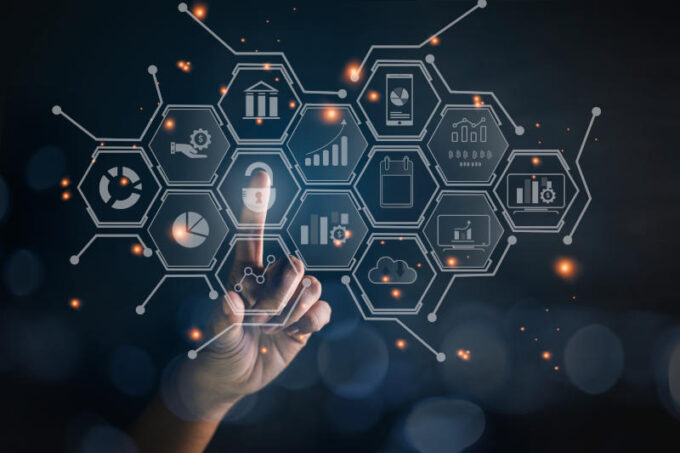
How to get sustainable business transformation right
Sustainable corporate change is a challenging feat to pull off. Julia Binder examines the barriers and drivers of change to increase your chances of success....

by Michael D. Watkins Published March 7, 2025 in Strategy • 8 min read
When choppy waters are crashing all around your business, it can be tough for even the most astute executives to perceive a clear way ahead. Effective organizational responses to volatile conditions require above all else that executive teams pull in the same direction.
Every C-suite executive brings a different perspective to the table, informed both by developments in their domain and by their personal experiences and biases. It’s the CEO’s job to orchestrate these contrasting views into a coherent, productive whole. To cope with the frequently chaotic business conditions, CEOs must implement a structured approach to alignment.
Below, I explore why alignment on external threats and opportunities is increasingly important and why it’s so difficult to achieve – and how two new, interconnected frameworks can drive more productive conversations about where your organization is and where it should go next.

Being able to sense and respond to the external environment has always been part of the leadership team’s remit. But in today’s highly dynamic business conditions, it is more important than ever. The pace of change means that leadership teams who fail to sense and respond to emerging threats and opportunities risk being blindsided. CEOs, exhausted by constant firefighting, often realize belatedly that more careful monitoring of the skyline could have allowed them to neutralize threats and manage issues long before they became critical.
The foundational task of leadership, therefore, is to develop a shared view of reality, sensing and responding to a complex and dynamic world.

“Of course, it’s completely normal – and desirable – for executives to have different viewpoints (moreover, absolute, unquestioning consensus carries its own risks)”
Without a shared view of reality, thinking strategically and making key operational decisions become much more difficult. Conflicting interpretations of external pressures generate fragmented or contradictory responses, leading to wasted resources and, ultimately, organizational confusion. For instance, if only some leaders regard technological disruption as an immediate threat, the organization may fail to allocate resources effectively or make timely investments, leading to a competitive disadvantage. Similarly, a misaligned assessment of the organization’s climate impact could result in disagreements over key sustainability initiatives and, consequently, missed opportunities for strategic positioning.
Operational vulnerabilities are also likely to emerge. If leaders fail to agree on the principal threats facing the organization, they may implement incompatible security measures or contradictory resilience strategies. That could increase exposure and exacerbate vulnerabilities.
Of course, it’s completely normal – and desirable – for executives to have different viewpoints (moreover, absolute, unquestioning consensus carries its own risks). But when leadership teams fail to achieve a reasonable degree of alignment on how to address their challenges, the negative consequences can be far-reaching.
I have developed two interconnected frameworks, which I call TSUNAMI and SURF.
It is not an easy task for the CEO to build alignment on organizational positioning in the external environment, as the most common frameworks for assessing the external world have significant limitations.
For example, the concept of volatility, uncertainty, complexity, and ambiguity (VUCA) came into widespread use following its introduction by the US military in the 1980s, but its system of categorization remains rather broad and academically detached from reality. Others, such as political, economic, social, and technological (PEST) or PESTLE (adding legal and environmental) provide structure but lack the detail to offer the alignment benefits of shared analysis.
What’s needed is a more extensive and practicable method for diagnosing challenges, developing the capabilities to meet them, and achieving consensus across the leadership team.
To meet this need, I have developed two interconnected frameworks, which I call TSUNAMI and SURF.
TSUNAMI is a tool for reassessing today’s turbulent environment and understanding the challenges it presents. SURF then suggests a practical approach to developing the necessary adaptive capabilities. Together, they can establish a strong platform on which to build effective strategies, adaptive organizations, and aligned, resilient leadership teams.

The TSUNAMI framework categorizes external pressures into seven dimensions, each with distinct implications for strategic decision-making:
Technological disruption: What impact do emerging technologies such as AI, automation, quantum computing, and blockchain have across industries? This dimension examines how these innovations transform operations, workforce needs, and consumer expectations.
Socio-economic shifts: What is the impact of changes in demographics, cultural values, urbanization, consumer behavior, digital trends, and wealth distribution?
Upheaval potential: This dimension involves evaluating the risk of large-scale disruptions, such as geopolitical tensions, economic crises, pandemics, and conflicts, and their impact on industries, supply chains, and international relations.
Network vulnerability: What are the risks inherent in interconnected systems, including cybersecurity threats, supply chain weaknesses, and financial or technological interdependencies that could trigger cascading failures?
Accelerating climate impacts: Environmental challenges such as resource depletion, climate change, and related extreme weather events are increasingly salient for business. What is their impact? And what are the opportunities for adaptation, innovation, and leadership?
Market transformation: This dimension examines the shifting competitive landscape driven by new business models, digital platforms, and disruptive innovations, and how organizations can adapt.
Impact intensity: How do pressures from diverse stakeholders – including governments, regulators, businesses, consumers, and communities – influence the organization’s social, environmental, and ethical responsibilities?
By systematically analyzing these seven interconnected dimensions, leaders can guide their teams to alignment on key challenges, before turning to the SURF framework to take the next step in developing more resilient strategies.

While TSUNAMI helps leaders assess the challenges they face, SURF provides a roadmap for developing critical adaptive capabilities via four elements:
Strategic thinking: The essential foundation that enables leaders and their teams to identify and prioritize emerging threats and opportunities in today’s high-TSUNAMI environments. The goal is to recognize the signals of change while there is still plenty of time to prepare and adapt – and to prioritize emerging threats and opportunities to mobilize the organization. Strategic thinking should be the organization’s navigational compass, providing the direction necessary to be effective in applying the other elements of SURF.
Unified ecosystem leadership: This element focuses on the need to develop and lead collaboration between partners, suppliers, customers, and even competitors. In today’s highly connected world, leaders must move beyond traditional value chain structures and create collaborative networks that can respond rapidly and effectively to emerging challenges. The mindset is one of “co-opetition,” in which businesses collaborate with rivals in certain areas for mutual benefit. It requires leaders to identify synergies among diverse stakeholders, the capacity to navigate complex and sometimes conflicting interests, and strong relationship-building skills.
Resilient organization: Faced by near-constant disruption, organizations need structures, systems, and, crucially, cultures that support agility and enable rapid adaptation to change. Flexible, network-based structures that can quickly be reconfigured work better than rigid hierarchies. A culture of continuous learning and experimentation is essential, as is the recognition and promotion of workforce diversity as a key contributor to innovation and problem-solving, and continuous training and development deployed to grow employees’ capabilities.
Resilience also requires robust mechanisms for gathering business intelligence with which to identify and prepare for environmental changes. This might involve implementing advanced data analytics systems or creating cross-functional teams dedicated to monitoring the horizon for anomalies. However, CEOs and leadership teams cannot simply hand over responsibility to a head of strategy or similar. While they should welcome input from such a figure, leadership needs to be hands-on in developing response strategies.
Flexible tenacity: A critical leadership quality during turbulent times, flexible tenacity combines adaptability, personal resilience, and the persistence or “grit” needed to maintain direction when buffeted by the seas of change. Leaders should work on developing emotional intelligence, stress management, and decision-making skills, while learning to balance analytical thinking with intuition and making sound decisions, even without all the desired information to hand. Leaders with flexible tenacity can adjust strategies and tactics and absorb setbacks while keeping long-term goals and core values in view.
Deploying the TSUNAMI and SURF frameworks is not complicated but using them effectively does require a methodical approach.
Deploying the TSUNAMI and SURF frameworks is not complicated but using them effectively does require a methodical approach. The CEO should introduce the frameworks and clarify their purpose, working through analysis against each dimension, synthesizing the resulting insights, identifying interdependencies, and prioritizing directed action.
There are three other success factors to consider:
When leadership teams achieve strong alignment on external threats and opportunities facing their businesses, the benefits are manifold. Aligned teams mobilize resources more effectively, make faster decisions, and maintain strategic coherence in turbulent environments. A systematic assessment based on the TSUNAMI and SURF frameworks can help CEOs transform their organizations’ vulnerabilities into competitive advantages.
In today’s exciting but turbulent business environment, organizations face dangerous riptides as they search for an advantage. With an enhanced ability to sense dynamics and agree on direction, leaders can avoid being pulled under and raise themselves up to the crest of the wave, however high that might seem from below.

Professor of Leadership and Organizational Change at IMD
Michael D Watkins is Professor of Leadership and Organizational Change at IMD, and author of The First 90 Days, Master Your Next Move, Predictable Surprises, and 12 other books on leadership and negotiation. His book, The Six Disciplines of Strategic Thinking, explores how executives can learn to think strategically and lead their organizations into the future. A Thinkers 50-ranked management influencer and recognized expert in his field, his work features in HBR Guides and HBR’s 10 Must Reads on leadership, teams, strategic initiatives, and new managers. Over the past 20 years, he has used his First 90 Days® methodology to help leaders make successful transitions, both in his teaching at IMD, INSEAD, and Harvard Business School, where he gained his PhD in decision sciences, as well as through his private consultancy practice Genesis Advisers. At IMD, he directs the First 90 Days open program for leaders taking on challenging new roles and co-directs the Transition to Business Leadership (TBL) executive program for future enterprise leaders, as well as the Program for Executive Development.

May 12, 2025 • by Julia Binder in Business transformation
Sustainable corporate change is a challenging feat to pull off. Julia Binder examines the barriers and drivers of change to increase your chances of success....

March 26, 2025 • by Didier Cossin, Yukie Saito in Business transformation
Hannele Jakosuo-Jansson, Executive Vice President of People and Culture at Neste – the world’s largest producer of renewable diesel and sustainable aviation fuel (SAF) – and a board member of Finnair, has...

January 22, 2025 • by Patrick Reinmoeller in Business transformation
In the face of growing competition from BYD and Tesla, Honda and Nissan's large merger wager may not be sufficient to bridge the gap. Thinking outside of the box may be essential...

January 22, 2025 in Business transformation
David Michels, CFO at Kinder Morgan, a leading US energy infrastructure company, explores how rapid AI and data center growth have quickly reshaped energy demand and what CFOs can do to navigate...
Explore first person business intelligence from top minds curated for a global executive audience